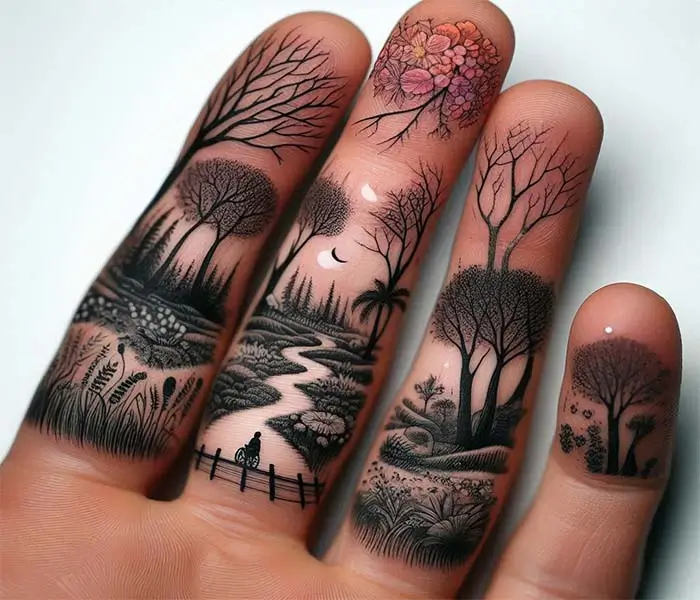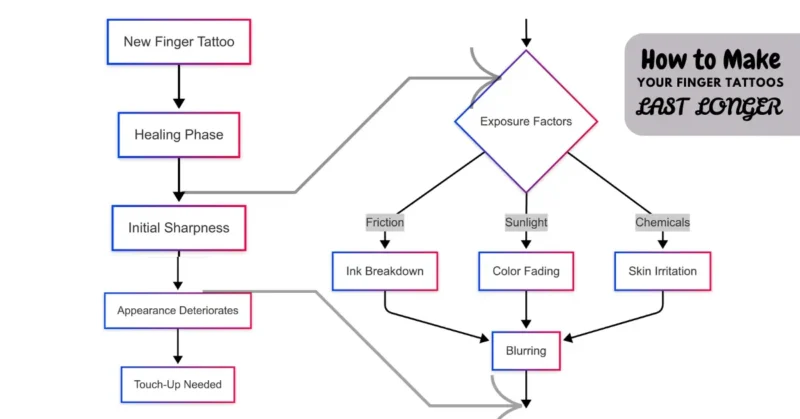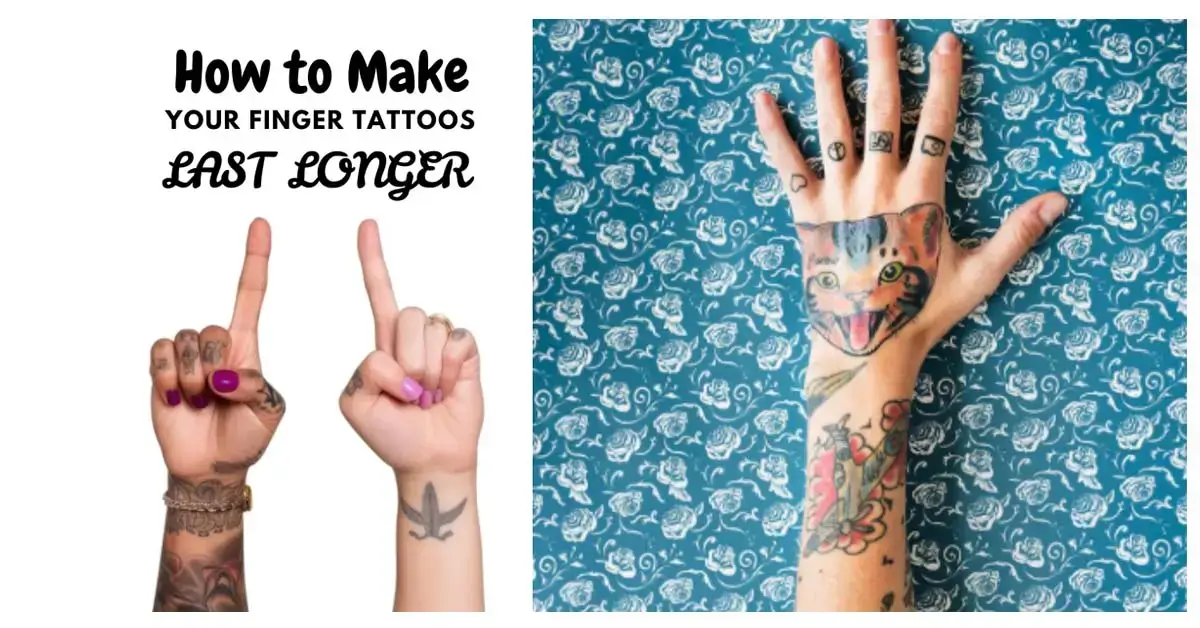Make your finger tattoos last longer with expert tips on care, design, and protection. Keep your ink sharp, bold, and beautiful for years to come!
Thank you for reading this post, don't forget to subscribe!Finger tattoos are a striking choice for those who seek minimalistic yet meaningful body art. However, unlike tattoos on other body parts, finger tattoos require special attention due to their delicate placement and constant exposure to the elements. In this comprehensive guide, we delve into everything you need to know—from selecting the right design to aftercare tips—to ensure your finger tattoos remain vibrant, sharp, and long-lasting.
What Makes Finger Tattoos Different?
Finger tattoos are applied on some of the most mobile and exposed parts of the body. The skin on the fingers is significantly thinner due to frequent stretching and friction from daily activities. Unlike areas with more fat or muscle, the finger’s structure makes ink retention a challenge. Understanding this anatomy is crucial for both the application of tattoos and their proper aftercare.

Skin Movement and Structure:
The dermis here is shallow, so tattoo ink can either fade quickly if not applied at the correct depth or spread if inserted too deeply. The skin also regenerates faster, pushing out pigment more rapidly than in areas like the arm or thigh.
Constant Exposure:
Fingers are almost always in use. From handwashing to typing, cleaning, and handling tools, your hands are up against a barrage of friction, moisture, chemicals, and UV rays.
Why Are Finger Tattoos So Popular Today?
Aesthetic Minimalism with Maximum Impact
We live in a world that celebrates individuality. Finger tattoos offer just that—a personal mark always in sight, discreet yet symbolic. They suit small words, initials, coordinates, or minimalist designs that resonate personally without requiring a large canvas.
Influencer & Celebrity Endorsement
From Rihanna’s symbolic lines to Beyoncé’s delicate “IV” tattoo, pop culture has turned finger tattoos into aspirational statements. Their visibility and subtlety make them Instagram-worthy, further fueling the trend.
A Permanent Accessory
Many individuals opt for ring tattoos as an alternative to traditional jewelry. Whether it’s a wedding band, Celtic knot, or infinity symbol, the finger tattoo becomes a permanent, wearable memory.
Key Factors That Impact Finger Tattoo Longevity
Skin Quality and Tattoo Placement
The primary reason for the fast fading of finger tattoos is skin turnover. Fingers shed skin more rapidly than most body parts. Plus, the sides and inner parts of fingers face more bending and rubbing, leading to quicker ink deterioration.
Exposure to Environmental Stressors
Whether it’s sun, soap, sanitizers, or friction from gloves, the fingers are constantly exposed to abrasion and chemicals. It weakens the ink pigments and breaks down the sharpness of the tattoo over time.
Tattoo Design: Keep It Bold and Simple
Design matters—more than you think. Thin lines, tiny patterns, or ultra-detailed illustrations are prone to blurring. Bold, minimal shapes fare better. Straight lines and geometric patterns can also warp due to the flexibility of the fingers.

Tattoo Ink Quality and Artist Expertise
A master tattoo artist doesn’t just draw—they calculate. They understand the depth of pigment insertion for specific areas. High-quality ink and the proper technique minimize early fading. Choosing an experienced artist ensures longevity from the first needle prick.
How Long Do Finger Tattoos Last?
The average lifespan of a finger tattoo, even with great care, is between 6 months and 3 years before a significant touch-up becomes necessary. Most finger tattoos begin showing signs of fading—blurred lines, patchiness, and dulled colors—within the first year.
Factors such as ink depth, individual skin type, the healing process, and exposure to elements all influence how quickly the tattoo fades.
How to Make Your Finger Tattoos Last Longer
Choose a Finger Tattoo Expert
Not all tattoo artists are equal when it comes to finger work. Seek professionals with a portfolio featuring clean, healed finger tattoos. These artists understand the necessary depth and how to counteract natural fading tendencies.
Stick to Bold, Simplified Designs
Opt for clean, bold lines rather than intricate flourishes. Minimalist symbols and thick outlines survive finger friction much better. Remember—less is more when it comes to longevity on fingers.
Follow Finger Tattoo Aftercare Instructions Precisely
The healing phase is critical. For the first two weeks:
- Wash with lukewarm water and fragrance-free, antibacterial soap.
- Pat dry—never rub.
- Apply a thin layer of unscented healing ointment or lotion.
- Avoid prolonged soaking in water (no swimming or dishwashing without gloves).
- Never pick at scabs.
It ensures the skin retains the ink instead of pushing it out.
Protect the Tattoo from Daily Wear
Apply SPF 50 sunscreen whenever exposed to sunlight. Use gloves during cleaning or gardening. Avoid abrasive soaps and alcohol-based sanitizers. Moisturize your hands regularly with a gentle, unscented lotion to preserve skin elasticity and hydration.
Schedule Routine Touch-Ups
Finger tattoos will fade. To keep your tattoo looking sharp, schedule a touch-up every 12 to 18 months. Include this in your initial tattoo investment budget.
Tattoo Fading Process and Preventative Care

Are Finger Tattoos Worth It?
The value of a finger tattoo is deeply personal. Here’s a balanced breakdown.
Pros
1. Style Statement: Finger tattoos are bold yet minimalist. They can be elegant, edgy, or symbolic—whatever suits your vibe.
2. Constant Reminder: Having a meaningful tattoo visible daily serves as a continuous motivator or emotional anchor.
3. Compact, Subtle Art: Perfect for those who love art but prefer minimalism over elaborate sleeves or large back pieces.
Cons
1. Shorter Lifespan: Finger tattoos fade faster than almost any other kind of tattoo. It’s not “if” they fade—it’s “when.”
2. More Maintenance: Expect to spend on touch-ups to retain the crispness of your design.
3. Professional Restrictions: Not every workplace welcomes visible tattoos. It’s essential to factor in professional visibility, especially for job interviews or formal settings.
FAQs on Finger Tattoos
Q: How to make a finger tattoo last longer?
To make a finger tattoo last longer, follow the aftercare instructions strictly. Clean it gently with antibacterial soap and avoid soaking it in water while it is healing. Keep the tattoo moisturized using unscented lotion to prevent dryness and cracking. Avoid harsh chemicals, direct sunlight, and excessive friction.
Always wear gloves when handling cleaning agents or doing chores. Use sunscreen to prevent UV rays from fading the ink. Regular touch-ups are also essential to maintain sharpness and vibrancy.
Q: How long does a tattoo on a finger last?
Finger tattoos usually begin to fade within 6 to 12 months due to frequent exposure and movement. With excellent aftercare and periodic touch-ups, they can last up to 3 to 5 years. However, they rarely retain the original sharpness for long without maintenance.
Constant bending, washing, and environmental factors break down the ink. Thicker lines and bold designs tend to last longer than fine details. Individual skin type and ink quality also play a role. Proper care can significantly extend their visibility and clarity.
Q: Why do finger tattoos fade quickly?
Finger tattoos fade quickly because the skin on fingers is thin, mobile, and regenerates rapidly. The constant movement and exposure to water, sunlight, and friction accelerate the breakdown of ink. Fingers lack the fat layer that helps retain ink in other body areas.
Washing hands, sanitizing, and daily wear all contribute to fading. Ink in this area tends to “fall out” during the healing process. The skin also sheds more quickly here, resulting in faster pigment loss. As a result, finger tattoos often require more touch-ups than others.
Q: How do I take care of finger tattoos?
Caring for a finger tattoo starts with gentle cleaning using antibacterial, fragrance-free soap. Pat it dry with a clean towel—never rub. To keep the region hydrated, apply a thin layer of healing ointment or a scent-free lotion.
Avoid submerging your hands in water during the healing period. Please protect it from sunlight and wear gloves when handling chemicals or cleaning agents. Never pick at scabs, as this can cause patchy ink loss. Once healed, apply sunscreen and moisturizer regularly to preserve its appearance.
Q: How to cover up a finger tattoo?
Covering a finger tattoo can be done with a well-planned new tattoo design or through cosmetic methods. Tattoo cover-up techniques include using darker ink or incorporating the old design into a new pattern. A professional tattoo artist can guide you on the best options, taking into account size and color.
For temporary coverage, full-coverage makeup or concealer can effectively mask the tattoo. Laser removal is also an option, but it may require multiple sessions. Rings and accessories can help distract from or partially hide the tattoo. Always consult a skilled artist for optimal results.
Q: Where is the most painful place to get a tattoo?
The most painful areas to get a tattoo are generally those with thin skin, little fat, and numerous nerve endings. These include the ribs, spine, inner thighs, armpits, and—yes—the fingers. Because of the close proximity of bones and the high density of nerves in the area, finger tattoos can be very painful. Other sensitive spots include the feet, neck, sternum, and face.
Pain levels also vary depending on personal pain tolerance and tattoo size. Generally, the less cushioning between skin and bone, the more intense the sensation. Always prepare mentally and physically for tattoos in high-pain areas.
Final Thoughts: Finger Tattoos—A Commitment to Art and Maintenance
Finger tattoos demand more than ink—they require intention, care, and realistic expectations. While they’re more prone to fading and touch-ups, they also offer unmatched visibility, elegance, and symbolism.
By selecting the right artist, adopting minimalist designs, and following a rigorous care routine, you can significantly extend the lifespan of your finger tattoo. Even with their quirks, finger tattoos remain a unique and powerful form of self-expression—remember, beauty on your fingertips comes with responsibility at your fingertips too.
Read more articles on Health and WellnessTips.
You might like to read:

